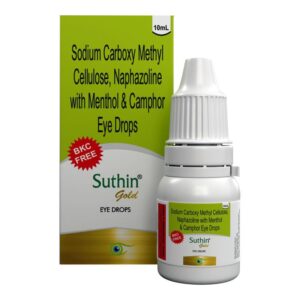MENTHOL + NAPHAZOLINE + SODIUM CARBOXY METHLY CELLULOSE
Menthol: Menthol is a terpene alcohol that is commonly used as a cooling agent and analgesic. It is derived from the peppermint plant and has a characteristic minty aroma. Menthol is used in various products such as cough drops, ointments, inhalers, and topical creams.
The primary use of menthol is for its ability to provide a cooling sensation that can help relieve minor pain, itching, and irritation. It works by activating the transient receptor potential melastatin 8 (TRPM8) receptors located on the skin and mucous membranes, which leads to a sensation of coldness. This can help to numb the area and provide temporary relief from discomfort.
Menthol is typically applied topically to the affected area in the form of creams, ointments, or gels. The concentration of menthol can vary in these products, but generally, it is between 0.5% to 2%. It is important to follow the instructions provided on the product packaging and consult a healthcare professional if unsure about the appropriate use or dosage.
Common side effects of menthol can include skin irritation, allergic reactions, or a mild burning or stinging sensation upon application. In rare cases, excessive application or ingestion of menthol can lead to more severe adverse effects such as dizziness, nausea, and difficulty breathing. It is essential to follow the recommended dosages and avoid using menthol on broken or injured skin.
Individuals with known allergies to menthol or mint-related products should avoid using menthol-containing products. Additionally, it is advisable to consult a healthcare professional before using menthol if you have any underlying medical conditions or are taking other medications to ensure there are no potential interactions or contraindications.
Naphazoline: Naphazoline is a drug commonly used as a nasal decongestant and an eye redness reliever. It belongs to the class of medications known as alpha-adrenergic agonists.
The primary use of naphazoline is to provide temporary relief from nasal congestion caused by allergies, colds, or sinusitis. It works by constricting the blood vessels in the nasal passages, which reduces swelling and allows for easier breathing. Naphazoline can also be found in eye drops to alleviate eye redness caused by minor eye irritation.
The usual recommended dose of naphazoline nasal spray is 2 to 3 sprays in each nostril up to 3 times a day, with a maximum of 3 days of continuous use. As for eye drops, a single drop is typically administered to each affected eye up to 4 times a day for a maximum of 3 days.
While naphazoline is generally well-tolerated, it can cause certain side effects. Common side effects include stinging, burning, dryness, or sneezing after nasal application. In the case of eye drops, users may experience temporary mild stinging or blurred vision. These effects are usually mild and temporary.
Using naphazoline for an extended period or in higher doses than recommended can lead to more severe side effects. These can include rebound congestion (nasal congestion returning once the medication is stopped), increased blood pressure, rapid heartbeat, headache, dizziness, nervousness, or insomnia. If any of these side effects occur or persist, it is essential to seek medical attention.
It is worth noting that naphazoline should not be used by individuals with certain medical conditions, such as high blood pressure, diabetes, heart disease, or thyroid problems, without consulting a healthcare professional. Additionally, it is important to follow the recommended dosing instructions and avoid using naphazoline for a prolonged period to minimize the risk of side effects.
Sodium Carboxy Methly Cellulose: Sodium Carboxy Methyl Cellulose, commonly known as sodium CMC or simply CMC, is a medication that belongs to a group of drugs called laxatives. It is primarily used to treat constipation by promoting bowel movements.
The mechanism of action of sodium CMC involves increasing the water content and volume in the intestinal tract. It forms a gel-like substance when it comes into contact with water, which helps to soften the stool and facilitate its passage through the digestive system. This increased water content also helps to stimulate peristalsis, the rhythmic contractions of the intestines that move feces along.
Sodium CMC is available in various forms, including tablets, capsules, powders, and as an ingredient in some oral liquids. The recommended dose may vary depending on the formulation and the severity of constipation. Generally, the starting dose for adults is around 500 mg to 2000 mg per day, divided into multiple doses. It is usually taken with a full glass of water and can be taken with or without food. It is important to follow the dosing instructions provided by the healthcare professional or the product label.
Like any medication, sodium CMC may cause some side effects. Common side effects include abdominal cramps, bloating, and diarrhea. These effects are usually mild and temporary, resolving on their own as the body adjusts to the medication. In rare cases, some individuals may experience allergic reactions, such as skin rash, itching, or swelling. If any of these serious side effects occur, it is important to seek immediate medical attention.
Overall, sodium CMC is a well-tolerated medication that can effectively relieve constipation. However, it is important to consult with a healthcare professional before starting any new medication to ensure its suitability and to determine the appropriate dosage for specific situations.

